Analysis of Family Influence and Childhood Obesity in Australia
VerifiedAdded on 2021/04/21
|7
|1656
|35
Report
AI Summary
This report examines the significant issue of childhood obesity in Australia, highlighting the crucial role of family influence and behavioral theories in addressing this public health concern. It delves into the alarming rise in childhood obesity rates, the associated health and social implications, and the economic burden on both families and the healthcare system. The report explores various behavioral theories, such as classical and operant conditioning, and their application in understanding and modifying behaviors related to eating and exercise. It discusses effective interventions at the family, school, and community levels, including strategies for promoting healthy lifestyles, weight management, and the importance of self-efficacy. The report also covers policy initiatives like food labeling, public awareness campaigns, and regulations on advertising to reduce obesity. Ultimately, the study emphasizes the need for integrated approaches, combining biomedical, behavioral, regulatory, and environmental interventions to prevent and manage childhood obesity effectively.
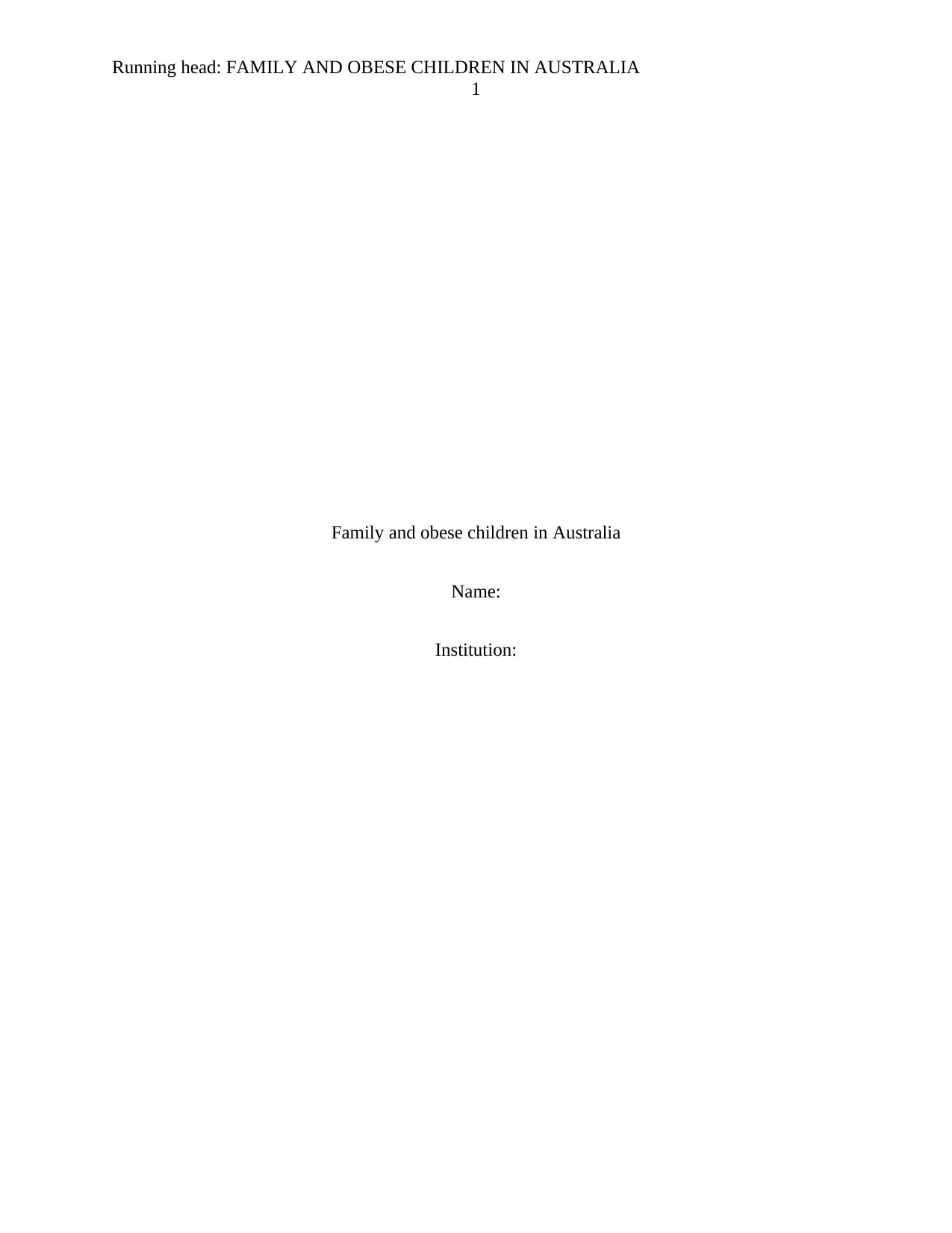
Running head: FAMILY AND OBESE CHILDREN IN AUSTRALIA
1
Family and obese children in Australia
Name:
Institution:
1
Family and obese children in Australia
Name:
Institution:
Paraphrase This Document
Need a fresh take? Get an instant paraphrase of this document with our AI Paraphraser
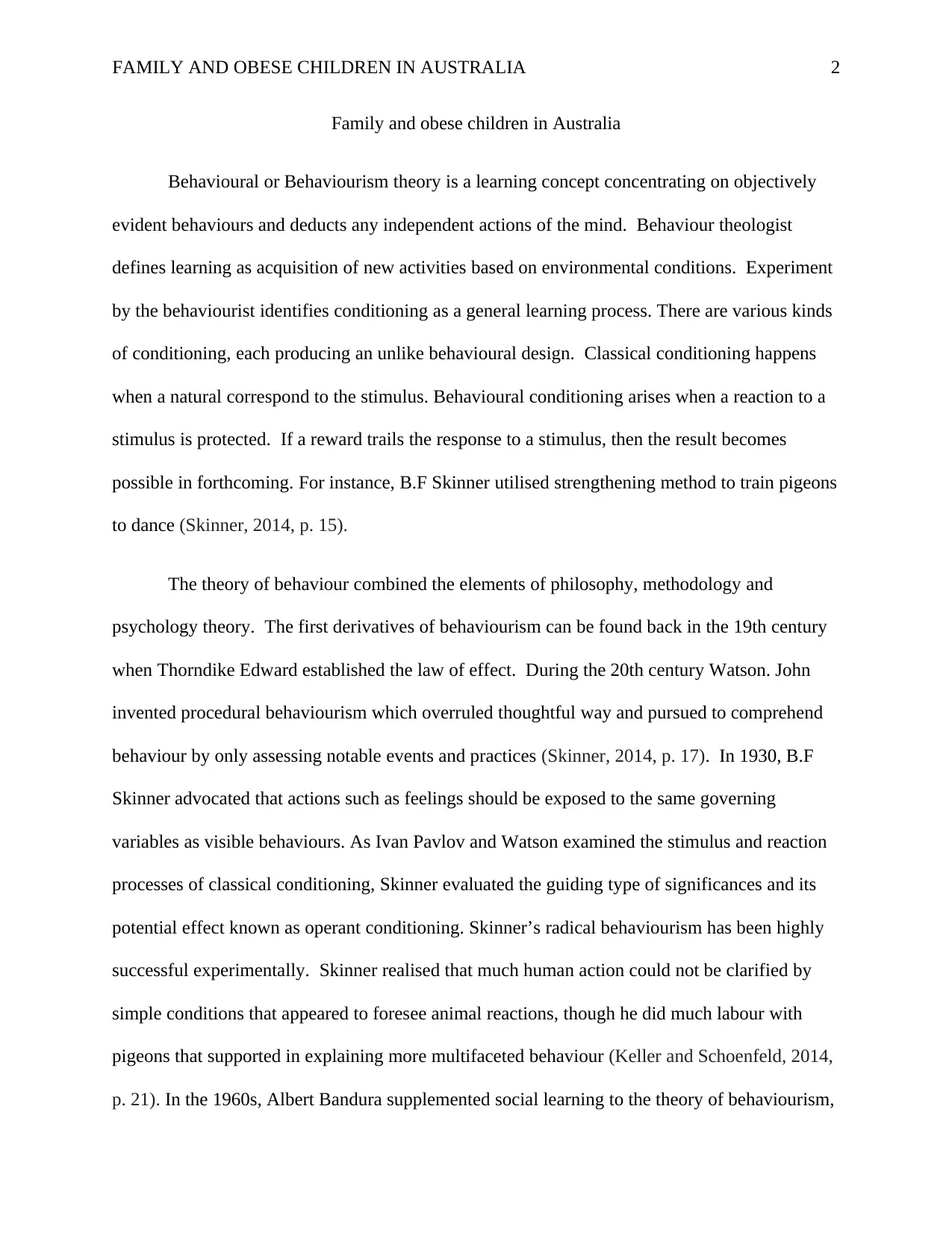
FAMILY AND OBESE CHILDREN IN AUSTRALIA 2
Family and obese children in Australia
Behavioural or Behaviourism theory is a learning concept concentrating on objectively
evident behaviours and deducts any independent actions of the mind. Behaviour theologist
defines learning as acquisition of new activities based on environmental conditions. Experiment
by the behaviourist identifies conditioning as a general learning process. There are various kinds
of conditioning, each producing an unlike behavioural design. Classical conditioning happens
when a natural correspond to the stimulus. Behavioural conditioning arises when a reaction to a
stimulus is protected. If a reward trails the response to a stimulus, then the result becomes
possible in forthcoming. For instance, B.F Skinner utilised strengthening method to train pigeons
to dance (Skinner, 2014, p. 15).
The theory of behaviour combined the elements of philosophy, methodology and
psychology theory. The first derivatives of behaviourism can be found back in the 19th century
when Thorndike Edward established the law of effect. During the 20th century Watson. John
invented procedural behaviourism which overruled thoughtful way and pursued to comprehend
behaviour by only assessing notable events and practices (Skinner, 2014, p. 17). In 1930, B.F
Skinner advocated that actions such as feelings should be exposed to the same governing
variables as visible behaviours. As Ivan Pavlov and Watson examined the stimulus and reaction
processes of classical conditioning, Skinner evaluated the guiding type of significances and its
potential effect known as operant conditioning. Skinner’s radical behaviourism has been highly
successful experimentally. Skinner realised that much human action could not be clarified by
simple conditions that appeared to foresee animal reactions, though he did much labour with
pigeons that supported in explaining more multifaceted behaviour (Keller and Schoenfeld, 2014,
p. 21). In the 1960s, Albert Bandura supplemented social learning to the theory of behaviourism,
Family and obese children in Australia
Behavioural or Behaviourism theory is a learning concept concentrating on objectively
evident behaviours and deducts any independent actions of the mind. Behaviour theologist
defines learning as acquisition of new activities based on environmental conditions. Experiment
by the behaviourist identifies conditioning as a general learning process. There are various kinds
of conditioning, each producing an unlike behavioural design. Classical conditioning happens
when a natural correspond to the stimulus. Behavioural conditioning arises when a reaction to a
stimulus is protected. If a reward trails the response to a stimulus, then the result becomes
possible in forthcoming. For instance, B.F Skinner utilised strengthening method to train pigeons
to dance (Skinner, 2014, p. 15).
The theory of behaviour combined the elements of philosophy, methodology and
psychology theory. The first derivatives of behaviourism can be found back in the 19th century
when Thorndike Edward established the law of effect. During the 20th century Watson. John
invented procedural behaviourism which overruled thoughtful way and pursued to comprehend
behaviour by only assessing notable events and practices (Skinner, 2014, p. 17). In 1930, B.F
Skinner advocated that actions such as feelings should be exposed to the same governing
variables as visible behaviours. As Ivan Pavlov and Watson examined the stimulus and reaction
processes of classical conditioning, Skinner evaluated the guiding type of significances and its
potential effect known as operant conditioning. Skinner’s radical behaviourism has been highly
successful experimentally. Skinner realised that much human action could not be clarified by
simple conditions that appeared to foresee animal reactions, though he did much labour with
pigeons that supported in explaining more multifaceted behaviour (Keller and Schoenfeld, 2014,
p. 21). In the 1960s, Albert Bandura supplemented social learning to the theory of behaviourism,
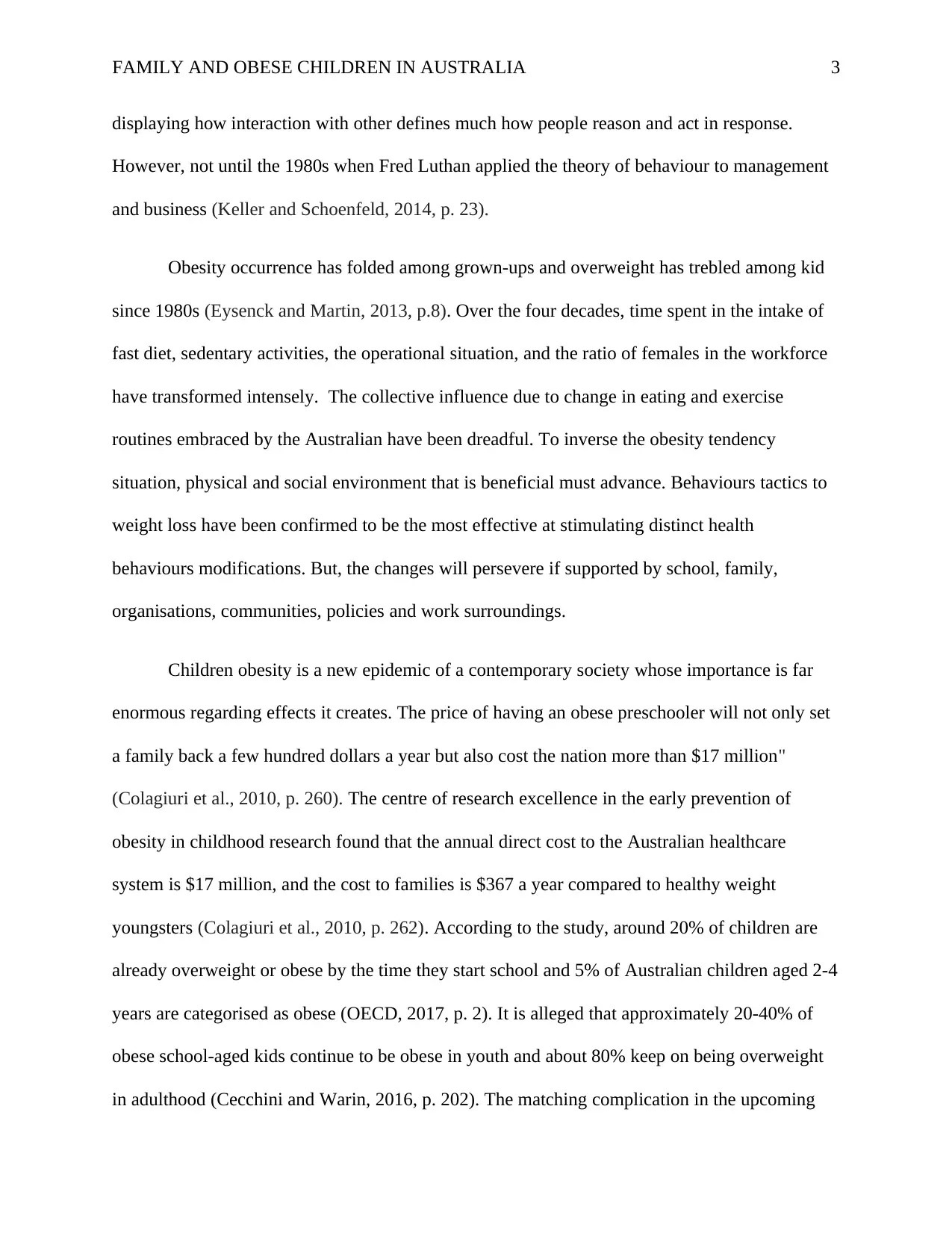
FAMILY AND OBESE CHILDREN IN AUSTRALIA 3
displaying how interaction with other defines much how people reason and act in response.
However, not until the 1980s when Fred Luthan applied the theory of behaviour to management
and business (Keller and Schoenfeld, 2014, p. 23).
Obesity occurrence has folded among grown-ups and overweight has trebled among kid
since 1980s (Eysenck and Martin, 2013, p.8). Over the four decades, time spent in the intake of
fast diet, sedentary activities, the operational situation, and the ratio of females in the workforce
have transformed intensely. The collective influence due to change in eating and exercise
routines embraced by the Australian have been dreadful. To inverse the obesity tendency
situation, physical and social environment that is beneficial must advance. Behaviours tactics to
weight loss have been confirmed to be the most effective at stimulating distinct health
behaviours modifications. But, the changes will persevere if supported by school, family,
organisations, communities, policies and work surroundings.
Children obesity is a new epidemic of a contemporary society whose importance is far
enormous regarding effects it creates. The price of having an obese preschooler will not only set
a family back a few hundred dollars a year but also cost the nation more than $17 million"
(Colagiuri et al., 2010, p. 260). The centre of research excellence in the early prevention of
obesity in childhood research found that the annual direct cost to the Australian healthcare
system is $17 million, and the cost to families is $367 a year compared to healthy weight
youngsters (Colagiuri et al., 2010, p. 262). According to the study, around 20% of children are
already overweight or obese by the time they start school and 5% of Australian children aged 2-4
years are categorised as obese (OECD, 2017, p. 2). It is alleged that approximately 20-40% of
obese school-aged kids continue to be obese in youth and about 80% keep on being overweight
in adulthood (Cecchini and Warin, 2016, p. 202). The matching complication in the upcoming
displaying how interaction with other defines much how people reason and act in response.
However, not until the 1980s when Fred Luthan applied the theory of behaviour to management
and business (Keller and Schoenfeld, 2014, p. 23).
Obesity occurrence has folded among grown-ups and overweight has trebled among kid
since 1980s (Eysenck and Martin, 2013, p.8). Over the four decades, time spent in the intake of
fast diet, sedentary activities, the operational situation, and the ratio of females in the workforce
have transformed intensely. The collective influence due to change in eating and exercise
routines embraced by the Australian have been dreadful. To inverse the obesity tendency
situation, physical and social environment that is beneficial must advance. Behaviours tactics to
weight loss have been confirmed to be the most effective at stimulating distinct health
behaviours modifications. But, the changes will persevere if supported by school, family,
organisations, communities, policies and work surroundings.
Children obesity is a new epidemic of a contemporary society whose importance is far
enormous regarding effects it creates. The price of having an obese preschooler will not only set
a family back a few hundred dollars a year but also cost the nation more than $17 million"
(Colagiuri et al., 2010, p. 260). The centre of research excellence in the early prevention of
obesity in childhood research found that the annual direct cost to the Australian healthcare
system is $17 million, and the cost to families is $367 a year compared to healthy weight
youngsters (Colagiuri et al., 2010, p. 262). According to the study, around 20% of children are
already overweight or obese by the time they start school and 5% of Australian children aged 2-4
years are categorised as obese (OECD, 2017, p. 2). It is alleged that approximately 20-40% of
obese school-aged kids continue to be obese in youth and about 80% keep on being overweight
in adulthood (Cecchini and Warin, 2016, p. 202). The matching complication in the upcoming
⊘ This is a preview!⊘
Do you want full access?
Subscribe today to unlock all pages.

Trusted by 1+ million students worldwide
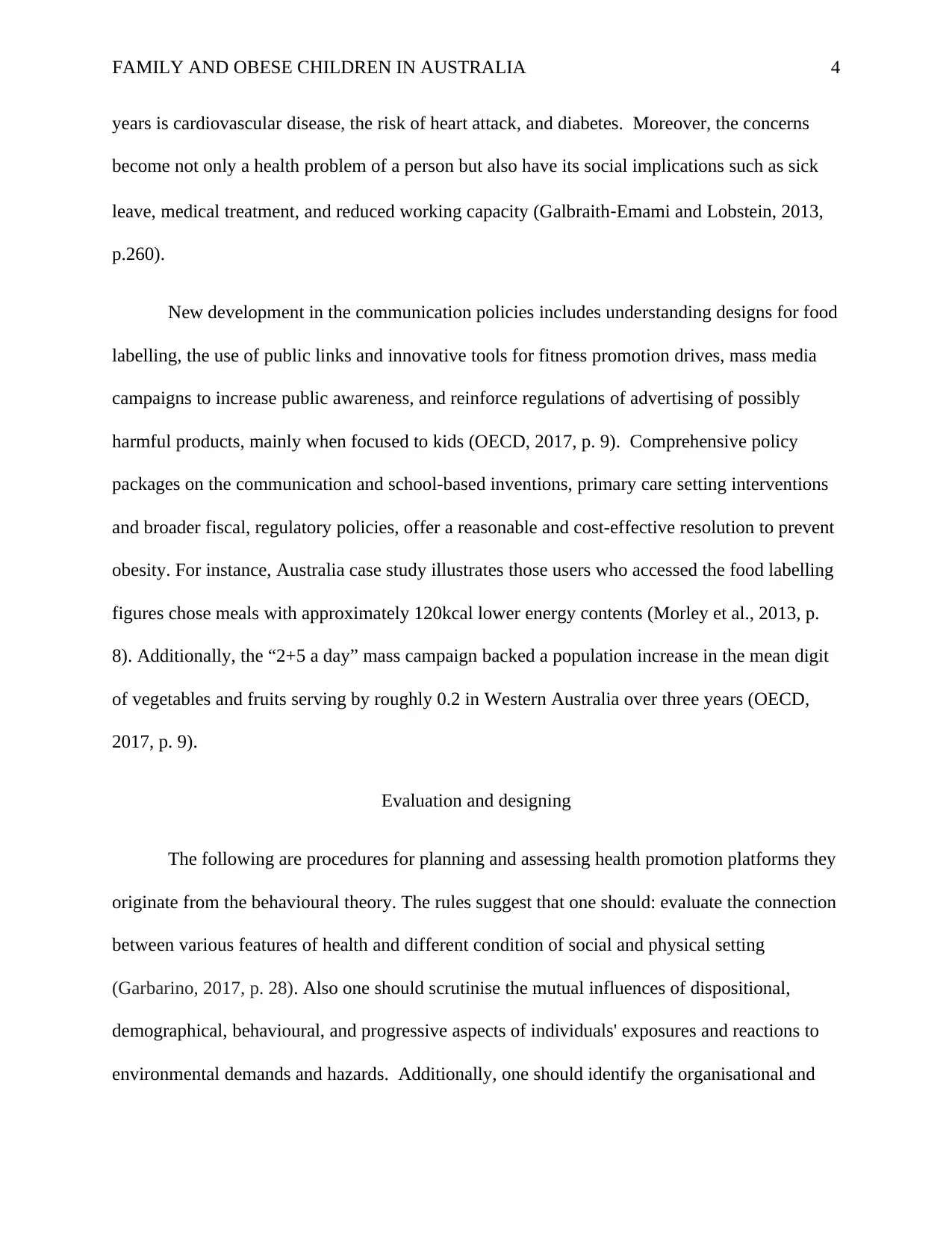
FAMILY AND OBESE CHILDREN IN AUSTRALIA 4
years is cardiovascular disease, the risk of heart attack, and diabetes. Moreover, the concerns
become not only a health problem of a person but also have its social implications such as sick
leave, medical treatment, and reduced working capacity (Galbraith‐Emami and Lobstein, 2013,
p.260).
New development in the communication policies includes understanding designs for food
labelling, the use of public links and innovative tools for fitness promotion drives, mass media
campaigns to increase public awareness, and reinforce regulations of advertising of possibly
harmful products, mainly when focused to kids (OECD, 2017, p. 9). Comprehensive policy
packages on the communication and school-based inventions, primary care setting interventions
and broader fiscal, regulatory policies, offer a reasonable and cost-effective resolution to prevent
obesity. For instance, Australia case study illustrates those users who accessed the food labelling
figures chose meals with approximately 120kcal lower energy contents (Morley et al., 2013, p.
8). Additionally, the “2+5 a day” mass campaign backed a population increase in the mean digit
of vegetables and fruits serving by roughly 0.2 in Western Australia over three years (OECD,
2017, p. 9).
Evaluation and designing
The following are procedures for planning and assessing health promotion platforms they
originate from the behavioural theory. The rules suggest that one should: evaluate the connection
between various features of health and different condition of social and physical setting
(Garbarino, 2017, p. 28). Also one should scrutinise the mutual influences of dispositional,
demographical, behavioural, and progressive aspects of individuals' exposures and reactions to
environmental demands and hazards. Additionally, one should identify the organisational and
years is cardiovascular disease, the risk of heart attack, and diabetes. Moreover, the concerns
become not only a health problem of a person but also have its social implications such as sick
leave, medical treatment, and reduced working capacity (Galbraith‐Emami and Lobstein, 2013,
p.260).
New development in the communication policies includes understanding designs for food
labelling, the use of public links and innovative tools for fitness promotion drives, mass media
campaigns to increase public awareness, and reinforce regulations of advertising of possibly
harmful products, mainly when focused to kids (OECD, 2017, p. 9). Comprehensive policy
packages on the communication and school-based inventions, primary care setting interventions
and broader fiscal, regulatory policies, offer a reasonable and cost-effective resolution to prevent
obesity. For instance, Australia case study illustrates those users who accessed the food labelling
figures chose meals with approximately 120kcal lower energy contents (Morley et al., 2013, p.
8). Additionally, the “2+5 a day” mass campaign backed a population increase in the mean digit
of vegetables and fruits serving by roughly 0.2 in Western Australia over three years (OECD,
2017, p. 9).
Evaluation and designing
The following are procedures for planning and assessing health promotion platforms they
originate from the behavioural theory. The rules suggest that one should: evaluate the connection
between various features of health and different condition of social and physical setting
(Garbarino, 2017, p. 28). Also one should scrutinise the mutual influences of dispositional,
demographical, behavioural, and progressive aspects of individuals' exposures and reactions to
environmental demands and hazards. Additionally, one should identify the organisational and
Paraphrase This Document
Need a fresh take? Get an instant paraphrase of this document with our AI Paraphraser
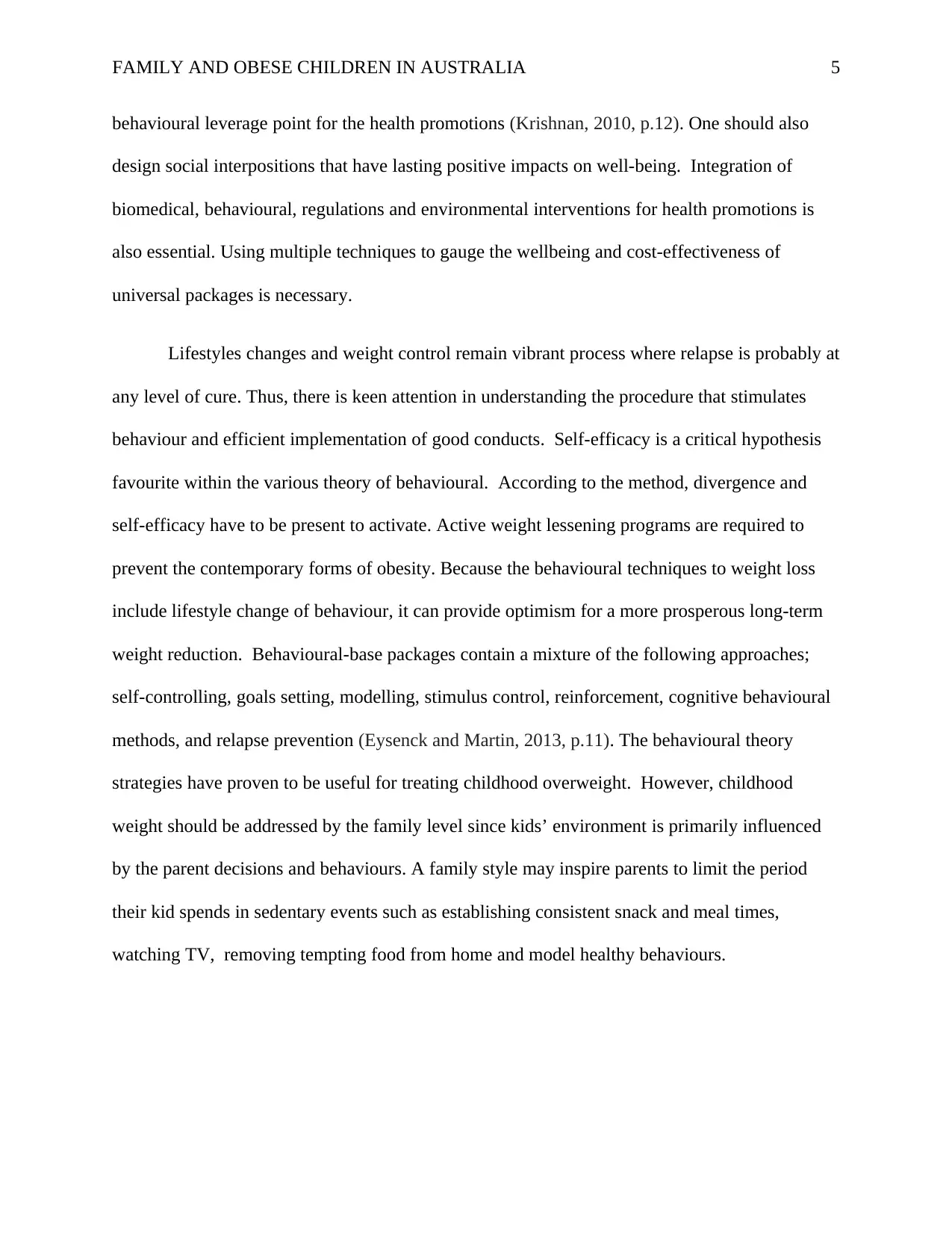
FAMILY AND OBESE CHILDREN IN AUSTRALIA 5
behavioural leverage point for the health promotions (Krishnan, 2010, p.12). One should also
design social interpositions that have lasting positive impacts on well-being. Integration of
biomedical, behavioural, regulations and environmental interventions for health promotions is
also essential. Using multiple techniques to gauge the wellbeing and cost-effectiveness of
universal packages is necessary.
Lifestyles changes and weight control remain vibrant process where relapse is probably at
any level of cure. Thus, there is keen attention in understanding the procedure that stimulates
behaviour and efficient implementation of good conducts. Self-efficacy is a critical hypothesis
favourite within the various theory of behavioural. According to the method, divergence and
self-efficacy have to be present to activate. Active weight lessening programs are required to
prevent the contemporary forms of obesity. Because the behavioural techniques to weight loss
include lifestyle change of behaviour, it can provide optimism for a more prosperous long-term
weight reduction. Behavioural-base packages contain a mixture of the following approaches;
self-controlling, goals setting, modelling, stimulus control, reinforcement, cognitive behavioural
methods, and relapse prevention (Eysenck and Martin, 2013, p.11). The behavioural theory
strategies have proven to be useful for treating childhood overweight. However, childhood
weight should be addressed by the family level since kids’ environment is primarily influenced
by the parent decisions and behaviours. A family style may inspire parents to limit the period
their kid spends in sedentary events such as establishing consistent snack and meal times,
watching TV, removing tempting food from home and model healthy behaviours.
behavioural leverage point for the health promotions (Krishnan, 2010, p.12). One should also
design social interpositions that have lasting positive impacts on well-being. Integration of
biomedical, behavioural, regulations and environmental interventions for health promotions is
also essential. Using multiple techniques to gauge the wellbeing and cost-effectiveness of
universal packages is necessary.
Lifestyles changes and weight control remain vibrant process where relapse is probably at
any level of cure. Thus, there is keen attention in understanding the procedure that stimulates
behaviour and efficient implementation of good conducts. Self-efficacy is a critical hypothesis
favourite within the various theory of behavioural. According to the method, divergence and
self-efficacy have to be present to activate. Active weight lessening programs are required to
prevent the contemporary forms of obesity. Because the behavioural techniques to weight loss
include lifestyle change of behaviour, it can provide optimism for a more prosperous long-term
weight reduction. Behavioural-base packages contain a mixture of the following approaches;
self-controlling, goals setting, modelling, stimulus control, reinforcement, cognitive behavioural
methods, and relapse prevention (Eysenck and Martin, 2013, p.11). The behavioural theory
strategies have proven to be useful for treating childhood overweight. However, childhood
weight should be addressed by the family level since kids’ environment is primarily influenced
by the parent decisions and behaviours. A family style may inspire parents to limit the period
their kid spends in sedentary events such as establishing consistent snack and meal times,
watching TV, removing tempting food from home and model healthy behaviours.
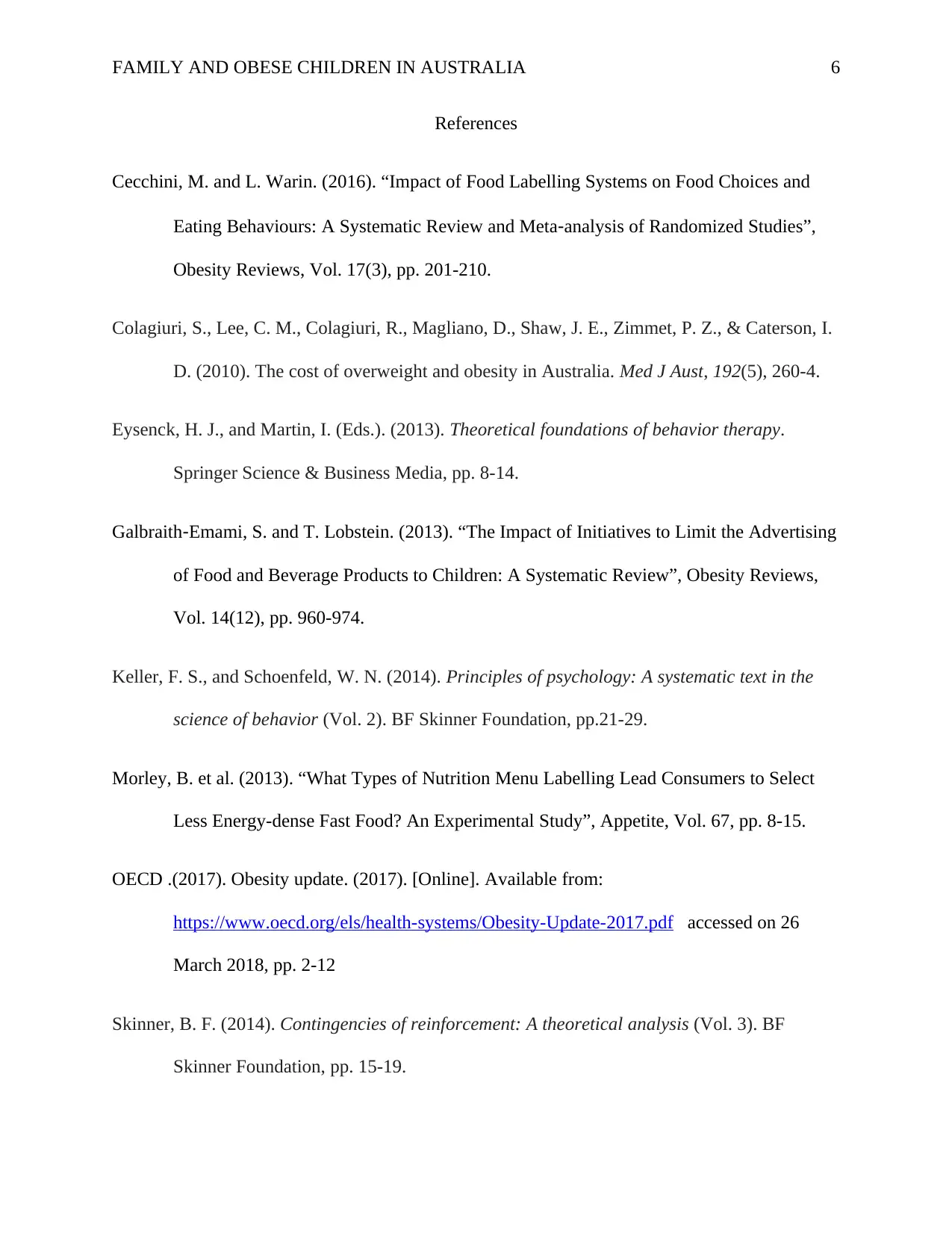
FAMILY AND OBESE CHILDREN IN AUSTRALIA 6
References
Cecchini, M. and L. Warin. (2016). “Impact of Food Labelling Systems on Food Choices and
Eating Behaviours: A Systematic Review and Meta‐analysis of Randomized Studies”,
Obesity Reviews, Vol. 17(3), pp. 201-210.
Colagiuri, S., Lee, C. M., Colagiuri, R., Magliano, D., Shaw, J. E., Zimmet, P. Z., & Caterson, I.
D. (2010). The cost of overweight and obesity in Australia. Med J Aust, 192(5), 260-4.
Eysenck, H. J., and Martin, I. (Eds.). (2013). Theoretical foundations of behavior therapy.
Springer Science & Business Media, pp. 8-14.
Galbraith‐Emami, S. and T. Lobstein. (2013). “The Impact of Initiatives to Limit the Advertising
of Food and Beverage Products to Children: A Systematic Review”, Obesity Reviews,
Vol. 14(12), pp. 960-974.
Keller, F. S., and Schoenfeld, W. N. (2014). Principles of psychology: A systematic text in the
science of behavior (Vol. 2). BF Skinner Foundation, pp.21-29.
Morley, B. et al. (2013). “What Types of Nutrition Menu Labelling Lead Consumers to Select
Less Energy-dense Fast Food? An Experimental Study”, Appetite, Vol. 67, pp. 8-15.
OECD .(2017). Obesity update. (2017). [Online]. Available from:
https://www.oecd.org/els/health-systems/Obesity-Update-2017.pdf accessed on 26
March 2018, pp. 2-12
Skinner, B. F. (2014). Contingencies of reinforcement: A theoretical analysis (Vol. 3). BF
Skinner Foundation, pp. 15-19.
References
Cecchini, M. and L. Warin. (2016). “Impact of Food Labelling Systems on Food Choices and
Eating Behaviours: A Systematic Review and Meta‐analysis of Randomized Studies”,
Obesity Reviews, Vol. 17(3), pp. 201-210.
Colagiuri, S., Lee, C. M., Colagiuri, R., Magliano, D., Shaw, J. E., Zimmet, P. Z., & Caterson, I.
D. (2010). The cost of overweight and obesity in Australia. Med J Aust, 192(5), 260-4.
Eysenck, H. J., and Martin, I. (Eds.). (2013). Theoretical foundations of behavior therapy.
Springer Science & Business Media, pp. 8-14.
Galbraith‐Emami, S. and T. Lobstein. (2013). “The Impact of Initiatives to Limit the Advertising
of Food and Beverage Products to Children: A Systematic Review”, Obesity Reviews,
Vol. 14(12), pp. 960-974.
Keller, F. S., and Schoenfeld, W. N. (2014). Principles of psychology: A systematic text in the
science of behavior (Vol. 2). BF Skinner Foundation, pp.21-29.
Morley, B. et al. (2013). “What Types of Nutrition Menu Labelling Lead Consumers to Select
Less Energy-dense Fast Food? An Experimental Study”, Appetite, Vol. 67, pp. 8-15.
OECD .(2017). Obesity update. (2017). [Online]. Available from:
https://www.oecd.org/els/health-systems/Obesity-Update-2017.pdf accessed on 26
March 2018, pp. 2-12
Skinner, B. F. (2014). Contingencies of reinforcement: A theoretical analysis (Vol. 3). BF
Skinner Foundation, pp. 15-19.
⊘ This is a preview!⊘
Do you want full access?
Subscribe today to unlock all pages.

Trusted by 1+ million students worldwide
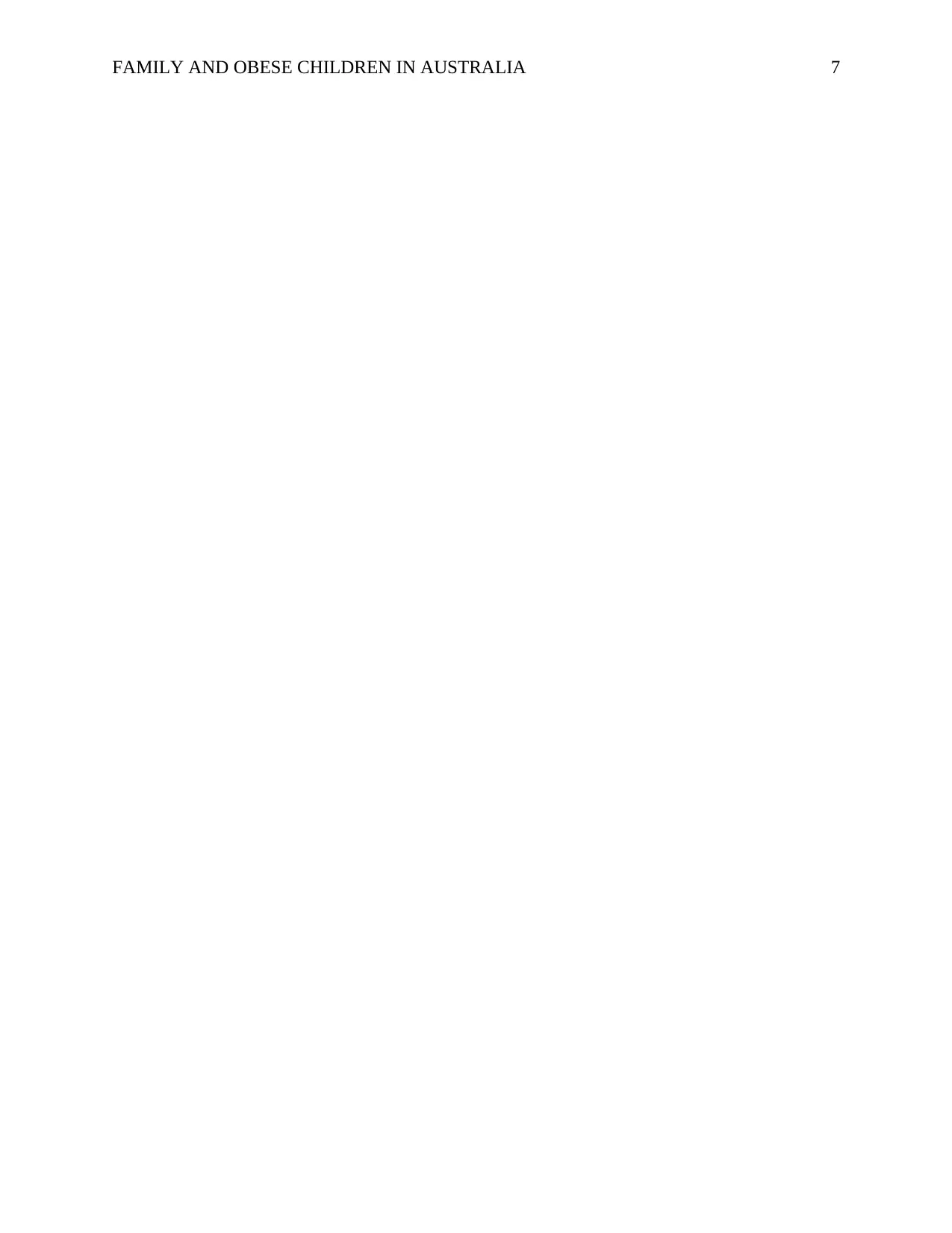
FAMILY AND OBESE CHILDREN IN AUSTRALIA 7
1 out of 7
Your All-in-One AI-Powered Toolkit for Academic Success.
+13062052269
info@desklib.com
Available 24*7 on WhatsApp / Email
![[object Object]](/_next/static/media/star-bottom.7253800d.svg)
Unlock your academic potential
Copyright © 2020–2025 A2Z Services. All Rights Reserved. Developed and managed by ZUCOL.
